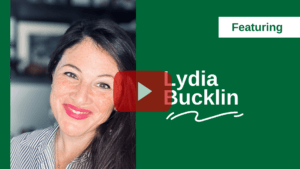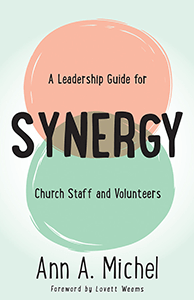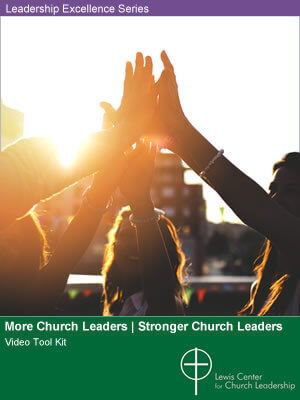
How can your congregation function as a community of ministers rather than a community gathered around a single minister? Lydia Bucklin explains the Mutual Ministry Initiative and how this approach to shared ministry is flourishing among smaller churches in the Upper Pennisula of Michigan.
Listen on Apple Podcasts | YouTube Music | Spotify
Watch on YouTube

- Transcript — Click or Tap to Read
-
Announcer: Leading Ideas Talks is brought to you by the Lewis Center for Leadership of Wesley Theological Seminary in Washington, DC. Subscribe free to our weekly e-newsletter, Leading Ideas, at churchleadership.com/leadingideas.
Leading Ideas Talks is also brought to you by Synergy, a leadership guide for church staff and volunteers. As more and more lay persons take on significant ministry roles, many of them feel ill-prepared underappreciated, and confused about their calls. Synergy is a leadership guide that speaks directly to their needs. Learn more and order now at churchleadership.com/books.
How can your congregation function as a community of ministers rather than a community gathered around a single minister? In this episode Lydia Bucklin explains the Mutual Ministry Initiative and how this approach to shared ministry is flourishing among smaller churches in the Upper Penninsula of Michigan.
Ann Michel: I’m Ann Michel. I’m a senior consultant with the Lewis Center for Church Leadership of Wesley Theological Seminary in Washington, DC. I’m also one of the editors of Leading Ideas e-newsletter and I am pleased to be the host of this episode of Leading Ideas Talks. My guest today is Lydia Kelsey Bucklin who serves as Canon to the Ordinary in the Episcopal Diocese of Northern Michigan and as Senior Advisor to the Mutual Ministry Initiative at Virginia Theological Seminary. I’m delighted to be talking with her today about a more collaborative, inclusive approach to leading faith communities. Welcome, Lydia!
You serve in the Upper Peninsula of Michigan, which is a pretty remote and sparsely populated part of our country. I wondered if you could describe the overall context and the typical profile of the churches you work with there.
Lydia Bucklin: Sure. Our diocese in the Episcopal Church is a community of congregations. We have about 24 congregations. And, as you said, the Upper Peninsula is pretty remote. We are three percent of the population of Michigan, but we’re 30 percent of the size. There’s a lot of forest and we’re surrounded by water. Our winter starts in October and ends in May. It’s actually snowing right outside my office right now. So, it’s a rugged place to be. Our folks are hardy and scrappy and resilient, and our churches are small but faithful. We were just at our recent diocesan meeting, and someone said, “Well, if we’ve been staying steady with 12 members for 200 years, I think maybe that’s okay. That’s just our size. And at this point, maybe we should stop feeling bad about ourselves, because this is just who we are.” Some of our congregations are about a dozen people. Some have 50 or 60, or a bit larger. And we also are doing some innovative things with Wild Church, which meets outdoors, and exploring what that might look like to take church outside the building. In general, we tend to rely on the faith that God has provided us everything we need for ministry because, if we didn’t, we probably wouldn’t keep going. We really utilize the gifts of everyone, and we are very connected in our local communities.
Ann Michel: Because these are mostly small communities, you’re relying on a program called the Mutual Ministry Initiative to help them organize themselves for ministry. I wonder if you could describe that initiative?
Lydia Bucklin: Sure. Mutual Ministry, in and of itself, is an ecclesiology. It’s a way of being and understanding church. It has been called in the past total ministry, baptismal ministry, ministry development, shared ministry. It has all these names. It really took hold in the 1980s and 1990s around the Episcopal Church as some bishops such as Wes Frensdorff and Tom Ray and others from places like Nevada, Wyoming, Alaska, Navajoland [Navajo Nation, which extends into Utah, Arizona, and New Mexico], these smaller dioceses in particular. These remote places were kind of the canaries in the coal mine, saying this idea of one clergy person per congregation who is paid through just one congregation isn’t sustainable anymore. So, 30 years ago, we started to experience what the rest of the church is experiencing now, especially post pandemic. At that time, they started to come together and have these think tanks and experimental ideas of how they might structure their judicatories. It was also an ecumenical movement, and there were some partnerships were formed.
In our particular context, we form ministry teams in local congregations who then do have the support of a seminary-trained ministry professional, what we call missioners. Other places have called them ministry developers. They might work with a few congregations. So, the paid clergy person (though that person doesn’t have to be ordained, but typically they are and definitely seminary trained), that’s the person who accompanies and walks alongside these ministry teams. Within the teams, there may be folks who are locally ordained and commissioned for ministry.
The Mutual Ministry Initiative is a more recent program that was funded by Lilly Endowment Inc. through Virginia Theological Seminary as an effort to give some more infrastructure. Thirty years later, we are now at a point again where even larger congregations and judicatories are saying, “How are you doing this? How have you been able to sustain your ministry in Northern Michigan? Might there be things that we can learn?” So, up here in Northern Michigan, we worked with the folks like Lisa Kimball and other folks in Lifelong Learning over at Virginia Theological Seminary to put together this grant that would help train and form leaders in this model of ministry that is very different than a seminary training in which someone comes out kind of being “the expert in the room” or the “father or mother knows best” but rather facilitates learning, facilitates shared ministry, and helps people discern their gifts — some different skills that we didn’t necessarily focus on with clergy in the past.
Ann Michel: On the ground in a local congregation, what does this Mutual Ministry team look like?
Lydia Bucklin: Yeah, that’s such a great question. It looks different in different places. Up here in Northern Michigan, we start with what’s called a discovery process that looks similar to a discernment process where folks in the congregation have acknowledged and believe that they have gifts, that there are people who are ready to use those gifts in a more formal way, a more liturgical way. We use liturgy to commission them as a team. It’s a formation process that goes a bit further than Sunday school or adult formation.
Through the discernment process, the discovery process, they name the gifts they see in each other. So, they might say, “Oh, Susan, you are a teacher at the local university and your speaking skills are amazing and the way you talk about theology. I could see you as a preacher here.” And Susan may say, “Who me? No. Oh, my gosh! I can’t imagine it!” So, we spend time together in community. Or someone, for instance, who’s a nurse or who does Meals on Wheels might have diaconal gifts, so people might say, “You are a deacon among us.” People hear from one another and from the community around what their gifts are.
They have an opportunity to affirm that with themselves. They spend about three years studying and learning and praying and being together in community, working with someone like me who serves as a missioner and a coach and a guide. We say you don’t have to be totally all in yet. We’ll get there. And we can continue in the discernment process. After those three years, a really solid team develops. That group is called a covenant group. I love the language that we covenant together with each other and with the rest of the congregation and with God. It says that we’re going to take this seriously, it’s something we show up for, and we come prepared.
People find this group to be life giving, and it’s deeply tied to their gifts and passions, so they show up for it. I think often people say, “How do you get people to even agree to this. It sounds like a big commitment. Everyone’s so busy these days.” But once people become part of this group, it’s so life giving and enriching with their ministry and daily life that they don’t want to miss it. They get excited. They might bring food to share. They offer prayers for each other. They share more deeply and with more vulnerability than they would just on Sunday morning.
Ann Michel: As this team evolves and matures together, do they end up taking on specific roles?
Lydia Bucklin: Yes. For instance, one of the small communities I serve has two people who were ordained as presbyters, as priests in the church, and then some other folks who were commissioned as preachers, someone else who’s commissioned as a deacon. When we get together, maybe quarterly or seasonally, to do the scheduling, we divvy up the roles. The nice thing about it is that you have lots of people using their gifts at different points so that no one person is overburdened with having to write the sermon every single week. Because we’ve got a team of folks, so it might be, maybe once a month. Even the person who’s discerned as a priest in this congregation, they might do it once a month. Then the lay leaders will do morning prayer once a month. They actually ask to do morning prayer because they like to take turns with different liturgy but also like to step into some leadership role not put everything on the shoulders of just the ordained person and getting overworked.
What we find when we share the responsibilities is that it feels more palatable and doable and more people know what’s going on. I would say everyone in the community is able to set the table for the Eucharist or to know what liturgical season it is. It’s just a higher sense of engagement with the worship service in general, with being able to figure out where we are in the lectionary. We all kind of know how to do that because some weeks someone might not be able to come because of the snow. So, it’s just a very hands-on way of being.
Ann Michel: I do find that often people who are not clergy are very reluctant to provide spiritual leadership, even if they have all kinds of gifts and all kinds of leadership potential, because they’re taught to think that spiritual authority resides exclusively in the clergy. I’m wondering what you find helpful in encouraging people to embrace a more robust sense of how God is calling and gifting each of us for ministry?
Lydia Bucklin: Such a great noticing and question. I think every part of the institutional church sets us up for this idea of abdicating our own sense of our gifts and spirituality and theology. Like, “I’m a theologian. No way! I don’t know those things.” And meanwhile, we have all these brilliant people in our midst who in their daily life are totally doing ministry. But they would never call it ministry because that ordained person who has the credentials and has gone to seminary is the expert. It’s intimidating to even speak the language.
I think part of that is even how we talk about theology, how we relate our faith stories to everyday life to help provide opportunity for people to make those connections in sitting and sharing stories and realizing the ways they are called. They’re already doing diaconal things. They’re already doing the priestly acts of reconciliation, the pastoral care for their neighbors or for their children. We spend a lot of time talking about and making that connection. It’s not having to learn one more thing, but it’s fully integrating ourselves into our faith and into our lives as followers of Jesus so that we have the language, and it feels more seamless when church isn’t just something that happens on Sunday morning, but that the people that we are caring for and who are caring for us can feel Jesus, and we see Jesus in them.
The more we live that way and model that, the more I think people then come to church being willing to share those experiences and be nourished to go back out and continue to do that. I think we talk about it a lot in our sermons. We make time during coffee hour during adult forums. We’re just very adamant about making that connection and continuing to teach and inform people as disciples in that way so that it starts to become our language and the way that we see ourselves. I would say at this point, after doing it for 30 years, it’s part of our DNA in Northern Michigan, to the point that people come from all over the country and really all over the world (a lot of Canadian visitors come to learn about an experience; we host two visitor weekends a year) because it is just such a different way we’ve learned to be.

Synergy: A Leadership Guide for Church Staff and Volunteers
The landscape of ministry is rapidly evolving as more and more lay persons take on significant ministry roles. Yet our mindset about ministry hasn’t been as quick to change. Lay ministry practitioners are often ill-prepared and underappreciated, confused about their call, and unsure of their theological identity. Dr. Ann A. Michel’s book Synergy is a leadership guide that speaks directly to their needs. Learn more and order now at churchleadership.com/books.
Ann Michel: This is so intriguing to me. I think underlying what you were just saying is a broader understanding of ministry. We really have to educate people about what ministry really is because it’s so easy for people to conflate ministry with the work of clergy and not have a more biblical, robust understanding of ministry. Following on that, I think there’s a tendency in small churches that maybe can’t afford any longer a full-time, seminary-educated clergy person to see this kind of approach to ministry as “less than.” How do you push back against the idea that this is a reluctant concession to necessity rather than a life-giving way of being.
Lydia Bucklin: Yes, oh, my gosh, absolutely! I feel like this is what I’m preaching all the time. I recently was in the Diocese of North Dakota where they are looking at more collaborative ways of being, given their remoteness and their smallness. And one of my friends who had invited me there said, “You know, there’s this worry that we are going to have to be like Northern Michigan.” And I thought, “Oh, that makes me sad. I love being part of Northern Michigan.”
But there is this sense of deficiency because we have been so obsessed with numbers. We’ve been so obsessed with our budgets, with the number of people in the pews, with being able to afford our buildings. Just the whole business of being church has been so wrapped up in this Western, capitalist, consumerist, transactional institutional sense of church. Even the language we use: the “congregants” “congregate” around the “presider” who “presides” on behalf of the people. When you don’t have that and you see others who do and who seem to be thriving and have the care and attention of this one paid person, it is very easy to feel “less than.” Instead of thinking that small is meager and puny, we say, “We’re small and mighty. We’re small and we have such a big impact.”
This way of being, for clergy in particular, is so liberating and freeing in terms of their wellness: to have a team of folks who take responsibility for their ministry and know their gifts and then to allow the clergy person to know and use their gifts without having to over-function in ways they’re not good at. I’m just one person. There are things I’m not great at that someone else does have gifts for. And when we really believe that and step into those gifts, we are able to retain and care for our clergy much more.
Ann Michel: I can imagine this ministry model in a small congregation that may not be able to have a paid person present all the time, but I understand it is also used in congregations that may have one or more paid clergy persons. How does it work in that situation?
Lydia Bucklin: Yeah, I would love to see this happen more, to be honest with you, because I think it’s an awesome setup. The Episcopal Cathedral in the Diocese of Minnesota in Minneapolis has this model. So, they have a dean, and they have some other paid clergy. They have a big staff. They also have a ministry team, and they have folks who have been trained, informed, and serve alongside. And I think, especially in a larger system, when you have multiple services and many different ministries going on, having a team that’s been commissioned to really own their ministry and to be also seen by the rest of the community as having some …. It’s not even about authority. I think it’s just about honoring. It’s again that covenant, this way of being together, that you know this group of people are going to show up, they’re going to be there, they’re going to be someone you could talk to. I personally think it takes a village to care for all of us not just children.
I think the exciting thing about mutual ministry is that there still is a place for paid professional seminary-trained experienced wise folks. It’s just a different type of role. But we certainly have lots of positions in our small diocese, and the way that we’re able to fund that is that our local communities all contribute 40 percent of their net operating income into one pool. It’s a very early church model where we put our resources into one bucket, and then everybody gets the same care. What that means for us is, we may have places that have big endowments from the iron ore days when they were booming towns. They are now very small, but they have millions of dollars in their endowment. Well, their 40 percent is going to be higher than a small town that doesn’t have that kind of endowment. But they all receive the same care.
That was a shift for us to say that, just because one community has more money, they don’t necessarily deserve a better pastoral presence or more pastoral presence. If we truly are the body of Christ, then when we put in together, when we all share, everyone can be cared for. I think that was the biggest shift for this diocese 30 years ago. That was probably a very hard ask for people to really go in on. It also means that our paid clergy are all paid the same amount, so there isn’t a competitive mindset: this position is better than that position is paid more or it’s worth more if you work at this church. That took away that hierarchy, as well.
Ann Michel: Wow! That’s just so fascinating to me. So, it’s not just shared ministry within the congregation, it is shared ministry among all the churches of the diocese. What a brilliant thing! I want to ask just a couple more questions. We’ve touched on the subject of language a couple of times. With the Feminist Movement in the 1970s and 1980s, we began to understand how our language was reinforcing patriarchy. In a similar way, my ears are very attuned to how the language of ministry reinforces clericalism. So, a word like “laity,” which in scripture means “people of God,” has in common usage come to mean amateur, inexpert, common, or secular as opposed to spiritual. And the whole language of pastoral identity is built around the metaphor of shepherding and sheep, which I find disempowering. So, I wondered, how do we learn to talk about ministries in ways that promote a more inclusive practice of ministry? I was very aware as I read your materials that you were avoiding certain terms, so I just wanted to ask about that.
Lydia Bucklin: Yeah. We are very careful about that. We don’t use “The L Word” very much. Folks are ordained or not ordained. It’s interesting. We just gathered for our diocesan convention, and you really wouldn’t know who is or isn’t ordained. You don’t receive different folders. We don’t even vote by orders. We changed our rules. If we really take the priesthood of all believers seriously, if we really take the ministry of all the baptized seriously, then does it make a difference?
Certainly, there are places for different skill sets. It is helpful to gather everyone who preaches to do some extra training on preaching or everyone who’s a worship leader. But a worship leader for a Sunday morning without a priest present also needs to learn about holding their body presence and voice and all those things. And so instead of gathering in clergy conferences, why aren’t we gathering for formation with all of us who are engaged in ministry? And so, we’ve made those shifts. You know, even the word “rector” means “ruler” in Latin. I mean, it’s steeped in this language.
How we do bulletins — if you look at like at the back of a service bulletin, who gets a title? It would probably be the Reverend Canon Lydia Kelsey Buckland and then Ann Michel, like you have any less work than I do, right? So, we don’t say that. I have friends, especially friends of color, women of color in particular, who have said, “I’ve worked very hard for this title. I need the respect of this title.” And I get that. I’m not saying get rid of all the titles. But if we’re going to use titles for some of us, let’s use titles for all of us. And that also means then figuring out what titles people deserve. We might have doctors in our midst. We might have judges who would get the title “The Very Honorable.” So, let’s be intentional about how we use our language. Because it does make a difference. Even the possessive pronouns of “my church”, “my congregation” — or in the Episcopal Church, if a priest moves on, we might say, “There’s a vacancy in the church.” Well, the church isn’t vacant. It’s still filled with people who are engaged in ministry who are the members of the church. Vacant because of that one person! That’s silly and that’s just not true.
Ann Michel: We are in such a liminal time when so many of our inherited paradigms of ministry are proving inadequate or unsustainable and all of us not knowing what the future is going to bring in terms of our congregations and in terms of our systems. I wonder, how do you see this idea of mutual ministry unfolding as the Church moves forward into such a such a different time when our institutional models of church seem to be waning.
Lydia Bucklin: I sure hope it’s embraced and not because it’s seen as the only option but because it’s truly where the Spirit is leading us. We have sustained this model for 30 years, even through the pandemic. I don’t know that we would still be a diocese if we look at those definitions of sustainability, viability, standing on our own. There are still people in the wider church who say, “Oh, that diocese in Northern Michigan should just get merged with another diocese, because they’re just too small to even be viable.”
I can tell you, for folks who live here and are part of the life and ministry, we are viable, we are vital. Their ministry is making a difference with Feeding America and with local schools and in countless ways. And we aren’t a burden to anyone else just by existing. I think the self-esteem of our church communities is severely lacking right now. A lot of my job is to go around and love people into just looking in the mirror. It’s just walking alongside and companioning and saying, “You’ve got this. You don’t need me to empower you. The Spirit has given you what you need, and you should be proud of what you’re doing.” And through this liminal space, I hope that we’re able to help support communities that think “Oh, we’re down to only 15 people. I guess we’re over.” But that also means making a shift.
We always say God gives us everything we need to do exactly what God’s calling us to do, but that involves listening to what God is calling us to do. And it’s not what we used to do. That’s hard for some of our generations who say, “We used to have a choir.” “What about the Sunday school?” Well, we can’t do those things, but what are the gifts? What are the needs of the community? How do we match those up? And how do we make an impact with what we’ve been given to do? And then, you see new life start to emerge. And sometimes it means sharing our building and more exciting ways to make do by taking on some entrepreneurial opportunities. But I do think there is a lot we can be doing when we believe in ourselves in this time of rediscovery. To me, it’s an exciting time.
Ann Michel: So often shared models of ministry are seen as “less than” or seen as a sign of decline or viewed as taking away the authority of the clergy. But I think it is God’s Spirit at work to renew the church. You have attested to that in wonderfully powerful ways today. I’m so grateful for your sharing and really grateful for the model and the witness of the work that you’re doing. I think I’m going to have to pay a visit to the Upper Peninsula of Michigan soon, because it sounds so very, very exciting. So, thank you, Lydia. Thank you for the work that you’re doing and for the conversation today.
Lydia Bucklin: Thanks. And it was a true blessing on my part.
Announcer: Thank you for joining us for Leading Ideas Talks.
Don’t forget to subscribe to our free weekly e-newsletter, Leading Ideas, to be notified when new episodes are published. Visit churchleadership.com/leadingideas.
Related Resources
- More Church Leaders |Stronger Church Leaders
 , a Lewis Center video tool kit resource
, a Lewis Center video tool kit resource - Toward a Compelling Theology of Lay Ministry by Ann A. Michel
- Bivocational By Choice featuring Ben Connelly — Leading Ideas Talks podcast episode | Podcast video | In-depth interview
- Synergy: A Leadership Guide for Church Staff and Volunteers by Ann A. Michel
- Expanding the Ministry of Laity in Worship by Andy Lunt and Ted Brown
Photo by Haley Rivera on Unsplash




